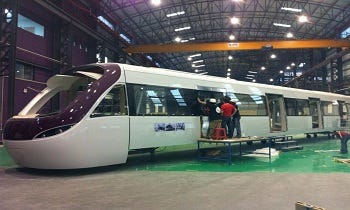Thermoset composite parts in monorail trains have the potential to reduce weight significantly as evidenced by development work and commercialization of components by Malaysian processor DK Composites Sdn. Bhd. (Melaka).In partnership with Gurit GmbH (Kassel, Germany) and its Australian subsidiary, together with Umeco (Warwickshire, UK), DK Composites has developed a series of glass-reinforced composite panels for users in Malaysia and India.
June 20, 2012
Thermoset composite parts in monorail trains have the potential to reduce weight significantly as evidenced by development work and commercialization of components by Malaysian processor DK Composites Sdn. Bhd. (Melaka).
In partnership with Gurit GmbH (Kassel, Germany) and its Australian subsidiary, together with Umeco (Warwickshire, UK), DK Composites has developed a series of glass-reinforced composite panels for users in Malaysia and India.
|
Monorails make weight reduction through heavy composite use. |
A ceiling, seat and apron door for Mumbai Monorail. The ceiling adopts a sandwich construction made from a phenolic/glass prepreg —offering fire retardant properties while delivering the target weight—and PET (polyethylene terephthalate) foam was developed. A vacuum-infused epoxy/glass laminate was used for the molding process. The ceiling weighs in at 413 kg per train carriage, representing a 53% weight reduction versus an aluminum composite panel with a tubular steel frame. The ceiling meets British Standard BS 6853 for fire/smoke/toxicity requirements. Development started in June 2010 and it was commercialized in February 2012.
The seat development started in April 2010 but was subsequently cancelled due to a change in specifications by the client. In order to further reduce weight, a high pressure laminate (HPL) and aluminum honeycomb were introduced together with acrylic resin, which enables a higher loading of flame retardant to be incorporated. The seat is also 53% lighter than a traditional seat made of stainless steel sheet with a tubular frame, and total seat weight per train carriage is 760 kg.
The apron door development started in August 2010. It is currently on hold and may be proposed to Kuala Lumpur Monorail instead. Here, a sandwich construction made from ATH- (alumina trihydrate) or red phosphorus-filled epoxy/glass prepreg and aluminum honeycomb was employed. The door enables a 49% weight reduction versus an aluminum composite panel with a tubular steel frame. 745 kg of weight comprises such doors in a train carriage.
Development of the nose cab mask for Kuala Lumpur Monorail commenced in November 2010, with the first production unit delivered in January 2012. Production is on-going. A sandwich construction made from red phosphorus filled epoxy/glass prepreg and PET foam is adopted. The main advantages of the new components include weight reduction, compliance with fire standards and appearance of the final parts (shapes impossible to realize using metal). The nose cap mask weighs in at 268 kg, which is 30% lighter than the previous hand-laminated polyester/glass/PVC foam system.
The overall target market for DK Composites work is the complete renovation of Malaysia's railway and mass transit systems using lightweight composites to replace metal parts for the coachwork, internal furniture and related parts. This effort could transform Malaysia into a leading provider of GFRP components for rail transport in ASEAN countries.
The team won a JEC Innovation Award in the Railway "exaequo" Category that will be presented at the upcoming JEC Asia show in Singapore to be held June 26-28, 2012. —[email protected]
About the Author(s)
You May Also Like



